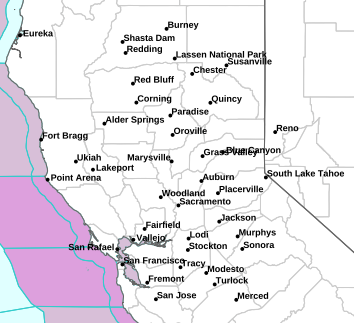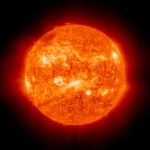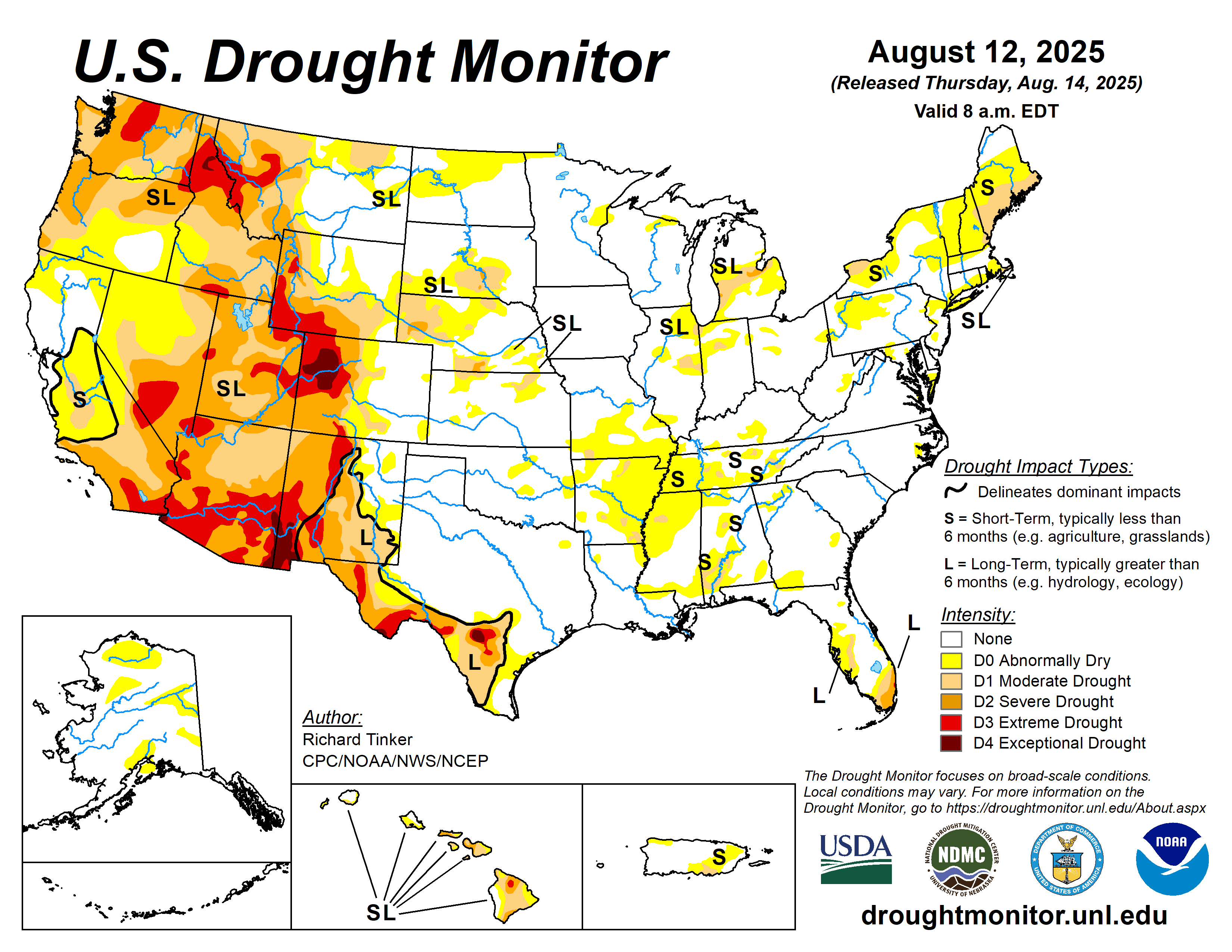Prognostic Discussion for 6 to 10 and 8 to 14 day outlooks
NWS Climate Prediction Center College Park, MD
300 PM EDT Fri April 26 2024
6-10 DAY OUTLOOK FOR MAY 02 - 06 2024
Model solutions depict a persistent longwave pattern into the beginning of May.
The GEFS along with the ECMWF and Canadian ensemble means feature a 500-hPa
trough of varying amplitude near the West Coast, a broad ridge over the central
contiguous U.S. (CONUS), and a trough across the western Atlantic. Positive
500-hPa height anomalies support increased above-normal temperature
probabilities from the Rockies to the East Coast. However, recent model
guidance shows at least a brief period of cooler-than-normal temperatures
affecting the Great Plains and Upper Mississippi Valley and this is reflected
in the ECMWF reforecast tool. Also, a cooling trend is forecast for the
Northeast and Northern Mid-Atlantic from day 6 to 10. Therefore, above-normal
temperature probabilities are lower today in portions of the central and
eastern CONUS. Anomalous mid-level troughing and enhanced onshore flow favor a
slight tilt towards below-normal temperatures across parts of the Pacific
Northwest and California.
An upstream trough along the West Coast generally favors a wetter-than-normal
outcome for much of the western and central CONUS. This is supported by the
GEFS and ECMWF reforecast tools. Enhanced onshore flow leads to increased
above-normal precipitation probabilities from the Pacific Northwest and
northern California eastward to the northern Rockies. Near normal precipitation
is forecast for the Great Basin and climatological dry areas of the Southwest.
Downstream of a mid-level ridge axis, near to below-normal precipitation is
favored across the eastern CONUS.
A 500-hPa trough over the Bering Sea favors above-normal precipitation for much
of Alaska. The uncalibrated model output is colder than the GEFS and ECMWF
reforecast tools. Given the lower 500-hPa heights in today’s manual blend and
expectation for more widespread cloudiness and increased chances of
precipitation, near normal temperatures are forecast for the southern
two-thirds of Alaska. Good model agreement continues on the favored
below-normal temperatures across the North Slope.
Based on the GEFS and ECMWF ensemble means, near normal temperatures and
precipitation are favored across much of Hawaii.
The official 6-10 day 500-hPa height blend consists of 35% of Today's 6z GFS
Ensemble Mean centered on Day 8, 35% of Today's 0z European Ensemble Mean
centered on Day 8, and 30% of Today's 0z Canadian Ensemble Mean centered on Day
8
FORECAST CONFIDENCE FOR THE 6-10 DAY PERIOD: Average, 3 out of 5, due to good
model agreement on the longwave pattern offset by increasing forecast
uncertainty across the eastern CONUS.
8-14 DAY OUTLOOK FOR MAY 04 - 10 2024
The GEFS, ECMWF, and Canadian ensemble means maintain the persistent longwave
pattern with 500-hPa troughs near both coasts of North America and a broad
ridge centered over the central CONUS. By the second week of May, the ensemble
means indicate a retrogression of the longwave pattern over North America with
a 500-hPa ridge axis shifting from the Mississippi Valley to the Rockies and an
amplifying trough closer to the East Coast. The Northeast and Mid-Atlantic is
vulnerable to backdoor cold fronts and cold air damming during the spring and
model guidance continues to show an increased chance for this to occur. A
slight lean towards below-normal temperatures is forecast for southern New
England and the coastal Northeast. Compared to yesterday,
coverage/probabilities for above-normal temperatures are reduced across the
eastern CONUS. The ridging aloft and associated positive 500-hPa height
anomalies favor above-normal temperatures from the Rockies to the Appalachians.
Conversely, a mid-level trough and negative 500-hPa height anomalies supports
slightly elevated below-normal temperature probabilities for southwest Oregon
and California.
The mid-level longwave trough upstream yields a relatively wet outlook across
much of the western and central CONUS. Forecast confidence is not high though
since the GEFS reforecast tool indicates weak probabilities. In addition, as
the ridge axis shifts westward to the High Plains, that would lead to a drier
pattern across the Great Plains later in week-2. Due to the amplifying trough
near the East Coast, a cold front may shift south and become stationary across
the southeastern CONUS. This could provide a focus for precipitation which
tilts the outlook towards the wet side for parts of this region. Farther to the
north across the eastern Great Lakes, Mid-Atlantic, and much of the Northeast,
below-normal precipitation is slightly favored and supported by the GEFS and
ECMWF reforecast tools.
A broad 500-hPa trough over the Bering Sea and western Mainland Alaska supports
increased above-normal precipitation probabilities nearly statewide for Alaska.
Similar to the 6-10 day period, the likelihood for enhanced precipitation and
cloudiness supports near normal temperatures for a majority of Alaska.
The GEFS ensemble mean features a mid-level trough lingering over the Central
Pacific. This is expected to promote cooler-than-normal temperatures for Hawaii
and increased chances of above-normal precipitation except for the Big Island.
The official 8-14 day 500-hPa height blend consists of: 35% of Today's 6z GFS
Ensemble Mean centered on Day 11, 35% of Today's 0z European Ensemble Mean
centered on Day 11, and 30% of Today's 0z Canadian Ensemble Mean centered on
Day 11
FORECAST CONFIDENCE FOR THE 8-14 DAY PERIOD: Below average, 2 out of 5, due to
a predicted retrogression of the longwave pattern and weak signals among the
precipitation tools.
FORECASTER: Brad Pugh
Notes:
Automated forecasts are issued on Saturday and Sunday. Occasionally manual
intervention is necessary to address quality control and consistency issues. In
these cases, forecasts are manually drawn but a full discussion is not issued.
The notation for the categorical forecast indicated on the maps is the same as
that in the tables: A-above N-near normal B-below
The temperature map shows regions with > 33% chance of being warmer (orange,
"A"), colder (blue, "B"), or close to (unshaded, "N"). Historical average
values for the calendar period of the forecast (dashes, "f"). Labels on the
shaded lines give the probability (> 33%) of the more likely category (B or A).
Probability of N is always < 40%.
The precipitation map shows regions with > 33% chance of being wetter (green,
"A"), drier (tan, "B"), or close to (unshaded, "n"). Historical median values
for the calendar period of the forecast (dashes, "inches"). Labels on the
shaded lines give the probability (> 33%) of the more likely category (B or A).
Probability of N is always < 40%.
In the southwest and other climatologically dry regions - there will be a
greater than 33.3% chance of no precipitation and occasionally even a normal
(i.e. Median) value of zero - especially during the dry seasons. In such cases
a forecast of near normal is effectively a forecast of little or no
precipitation.
The climate prediction center uses 1991-2020 base period means as reference in
the climate outlooks.
The next set of long-lead monthly and seasonal outlooks will be released on May
16.
Analogs to the 5 day mean observed pattern centered 3 days ago (D-3)
for the region from 20N to 70N latitude and 175E to 60W longitude
include the 5 day periods centered on the following dates:
19660425 - 19900507 - 20040416 - 19900418 - 19740429
Analogs to the 7 day mean observed pattern centered 4 days ago (D-4)
for the region from 20N to 70N latitude and 175E to 60W longitude
include the 7 day periods centered on the following dates:
20040415 - 19640407 - 19740428 - 19900418 - 19900508
6-10 DAY OUTLOOK TABLE
Outlook for May 02 - 06 2024
STATE TEMP PCPN STATE TEMP PCPN STATE TEMP PCPN
WASHINGTON N A OREGON B A NRN CALIF B A
SRN CALIF N N IDAHO A A NEVADA A A
W MONTANA N A E MONTANA A A WYOMING A N
UTAH A N ARIZONA A N COLORADO A N
NEW MEXICO A A N DAKOTA A A S DAKOTA A A
NEBRASKA A A KANSAS A A OKLAHOMA A A
N TEXAS A A S TEXAS A A W TEXAS A A
MINNESOTA A A IOWA A A MISSOURI A A
ARKANSAS A A LOUISIANA A N WISCONSIN A N
ILLINOIS A A MISSISSIPPI A A MICHIGAN A N
INDIANA A N OHIO A N KENTUCKY A N
TENNESSEE A A ALABAMA A A NEW YORK A B
VERMONT A B NEW HAMP A B MAINE A N
MASS A B CONN A B RHODE IS A B
PENN A B NEW JERSEY A B W VIRGINIA A B
MARYLAND A B DELAWARE A B VIRGINIA A B
N CAROLINA A B S CAROLINA A N GEORGIA A N
FL PNHDL A N FL PENIN A B AK N SLOPE B A
AK ALEUTIAN N A AK WESTERN N A AK INT BSN N A
AK S INT N A AK SO COAST N A AK PNHDL N A
8-14 DAY OUTLOOK TABLE
Outlook for May 04 - 10 2024
STATE TEMP PCPN STATE TEMP PCPN STATE TEMP PCPN
WASHINGTON N A OREGON N A NRN CALIF B A
SRN CALIF B N IDAHO A A NEVADA N A
W MONTANA A A E MONTANA A N WYOMING A N
UTAH A N ARIZONA A N COLORADO A N
NEW MEXICO A A N DAKOTA A A S DAKOTA A A
NEBRASKA A A KANSAS A A OKLAHOMA A A
N TEXAS A A S TEXAS A A W TEXAS A A
MINNESOTA A A IOWA A A MISSOURI A A
ARKANSAS A A LOUISIANA A N WISCONSIN A N
ILLINOIS A N MISSISSIPPI A A MICHIGAN A B
INDIANA A N OHIO A B KENTUCKY A N
TENNESSEE A N ALABAMA A A NEW YORK N B
VERMONT N B NEW HAMP N N MAINE N N
MASS B N CONN B B RHODE IS B N
PENN A B NEW JERSEY B B W VIRGINIA A B
MARYLAND N B DELAWARE N B VIRGINIA A B
N CAROLINA A N S CAROLINA A N GEORGIA A A
FL PNHDL A N FL PENIN A N AK N SLOPE B A
AK ALEUTIAN N A AK WESTERN N A AK INT BSN N A
AK S INT N A AK SO COAST N A AK PNHDL N A
LEGEND
TEMPS WITH RESPECT TO NORMAL PCPN WITH RESPECT TO MEDIAN
A - ABOVE N - NEAR NORMAL A - ABOVE N - NEAR MEDIAN
B - BELOW B - BELOW
THE FORECAST CLASSES REPRESENT AVERAGES FOR EACH STATE. NORMAL
VALUES - WHICH MAY VARY WIDELY ACROSS SOME STATES - ARE
AVAILABLE FROM YOUR LOCAL WEATHER SERVICE FORECAST OFFICE.
FOR ADDITIONAL INFORMATION SEE MESSAGE FXUS06 KWBC - ON AWIPS AS
PMDMRD.
$$
|






 Air Quality
Air Quality
























